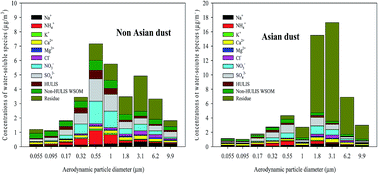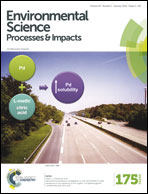Size distribution and sources of humic-like substances in particulate matter at an urban site during winter
Abstract
This study investigates the size distribution and possible sources of humic-like substances (HULIS) in ambient aerosol particles collected at an urban site in Gwangju, Korea during the winter of 2015. A total of 10 sets of size-segregated aerosol samples were collected using a 10-stage Micro-Orifice Uniform Deposit Impactor (MOUDI), and the samples were analyzed to determine the mass as well as the presence of ionic species (Na+, NH4+, K+, Ca2+, Mg2+, Cl−, NO3−, and SO42−), water-soluble organic carbon (WSOC) and HULIS. The separation and quantification of the size-resolved HULIS components from the MOUDI samples was accomplished using a Hydrophilic–Lipophilic Balanced (HLB) solid phase extraction method and a total organic carbon analyzer, respectively. The entire sampling period was divided into two periods: non-Asian dust (NAD) and Asian dust (AD) periods. The contributions of water-soluble organic mass (WSOM = 1.9 × WSOC) and HULIS (=1.9 × HULIS-C) to fine particles (PM1.8) were approximately two times higher in the NAD samples (23.2 and 8.0%) than in the AD samples (12.8 and 4.2%). However, the HULIS-C/WSOC ratio in PM1.8 showed little difference between the NAD (0.35 ± 0.07) and AD (0.35 ± 0.05) samples. The HULIS exhibited a uni-modal size distribution (@0.55 μm) during NAD and a bimodal distribution (@0.32 and 1.8 μm) during AD, which was quite similar to the mass size distributions of particulate matter, WSOC, NO3−, SO42−, and NH4+ in both the NAD and AD samples. The size distribution characteristics and the results of the correlation analyses indicate that the sources of HULIS varied according to the particle size. In the fine mode (≤1.8 μm), the HULIS composition during the NAD period was strongly associated with secondary organic aerosol (SOA) formation processes similar to those of secondary ionic species (cloud processing and/or heterogeneous reactions) and primary emissions during the biomass burning period, and during the AD period, it was only associated with SOA formation. In the coarse mode (3.1–10 μm), it was difficult to identify the HULIS sources during the NAD period, and during the AD period, the HULIS was most likely associated with soil-related particles [Ca(NO3]2 and CaSO4) and/or sea-salt particles (NaNO3 and Na2SO4).

- This article is part of the themed collection: Natural Organic Matter

 Please wait while we load your content...
Please wait while we load your content...